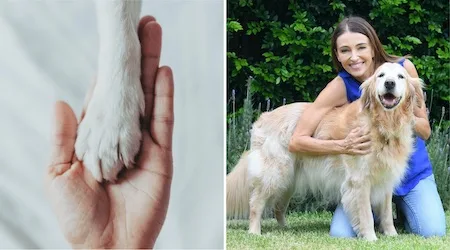How to deal with separation anxiety in dogs

With many of us getting ready for post-lockdown life, veterinarian Dr Katrina Warren shares her 5 top tips to help ease separation anxiety issues in dogs.
This year has certainly seen huge changes in the way we are living, and I think it's safe to say that most pets have enjoyed having their owners at home a lot more. Many have never had this much attention and dogs are getting more walks than ever.
Pet adoption rates are also through the roof and many people are purchasing puppies as "isolation buddies " after finding themselves suddenly grounded and craving companionship. I am personally very thankful for the company of my own pets right now, so I really do understand the pleasure our furry friends bring at this uncertain time.
However, I'm concerned that we'll see many dogs with separation issues when things return to normal in a few months. This is a situation that new pet owners often face. Regardless of the world circumstances, they want to spend lots of time with their new dog early on and may then realise that's not possible or sustainable longer-term. Many pets currently have someone home with them 24 hours a day, but it will not be like this forever.
Chill, my Border Collie, loves to be close by my side and will happily follow me from room to room if I allow it. While it's comforting to have him near me, I make a conscious effort to put him outside or in his crate for at least an hour, twice a day. When I place him outside, I always give him a toy that has food inside it. This gives him something to do and makes his time alone positive and rewarding.
Chill has been getting more walks and longer exercise periods than previously, so I am now focusing on a routine that is more manageable long term. I am lucky that my work is flexible, but for people who will be out during the day, they should start structuring their walks around what will be manageable once they are back at work.
Dogs are social creatures and need to learn coping skills to be comfortable being left unattended. Otherwise, they may become anxious when left alone and this can result in destructive behaviour.
Below are some tips to help avoid separation issues down the track:
1. Teach your puppy to be comfortable alone
As tempting as it is to let your puppy follow you from room to room or to carry them around all day, this can lead to them becoming overly dependent on you and potentially anxious when left alone. It's essential to teach them to spend time on their own. A playpen or crate can help keep them secure when you're not in the same room to supervise them.
Allocate some time each day when you make sure your puppy is alone – after playtime is good. Make sure they have had an opportunity to go to the toilet and give them something safe to chew on to help them settle.
If you are planning on your puppy or dog spending time outside during the day when you return to work, it is essential that you set this up from the beginning.
Adult dogs should also spend time alone. When you are home, put your dog outside for short periods while offering a chew toy or encourage them to settle on their bed or in a crate while you move around different parts of the house.
2. Exercise
Many of our dogs are getting more exercise than ever before. Maintaining an exercise routine will be important once you start leaving the house more or your dog may become bored and possibly destructive. This is especially important for adolescent dogs and active breeds.
Be mindful of the amount of exercise you are giving your dog during isolation and ask yourself how much exercise you will be able to maintain when circumstances change.
3. Make a safe space for your dog
This could be a kennel, pen, crate or bed area where they will not be disturbed by family members. Children should be taught to respect this "safe place" and should not be allowed to interact with their pet when they are there.
Some pets may benefit from a walled bed such as the Snooza Cuddler bed because of the walls and deep sleeping area that allows them to snuggle and feel secure. The Snooza Snuggler also has walls but provides a firmer orthopaedic base for those dogs who need it.
4. Consider your routine
Dogs like routine, it helps them feel secure. Try to create a routine that will also work when you are back at work – be mindful of feeding times and exercise times. Make the rules of the house clear and be consistent. For example, don't let them spend time on the couch or bed now just because you are bored if that will be off bounds later.
5. Set up good chew habits
Teach your puppy or dog what is acceptable for them to chew on and only give them chew toys that are clearly distinguishable from household items. When you want your pet to have some quiet time, give them a safe chew toy so they learn to associate this time with something positive. When you start to leave the house more, you can give them a chew toy to help them relax and keep them occupied.
Dr. Katrina Warren is a veterinarian best known for her work in the media as a presenter and spokesperson. She has worked across all media platforms, including TV, radio, print and online; has authored four books, hosted many events and most recently created an online education program for dog owners. Dr. Katrina Warren has a genuine love for animals and her real passion is helping pet owners enhance the special bond that is shared with pets. Katrina is a proud ambassador for Snooza Pet Products.
Disclaimer: The views and opinions expressed in this article (which may be subject to change without notice) are solely those of the author and do not necessarily reflect those of Finder and its employees. The information contained in this article is not intended to be and does not constitute financial advice, investment advice, trading advice or any other advice or recommendation of any sort. Neither the author nor Finder have taken into account your personal circumstances. You should seek professional advice before making any further decisions based on this information.
Read more Finder X columns
- The Google Pixel 9a is officially on sale in Australia – and I’m kind of obsessed
- What to do when US tariffs impact your super
- Google Pixel 9a vs Pixel 9: There’s a clear winner – make sure you pick right
- Hare-raising spending: Aussies set to spend $4.8 billion on Easter
- My expert frequent flyer points secrets revealed (the Woolies one is amazing)
Image credits: Getty Images, Supplied (Dr Katrina Warren)
Ask a question
